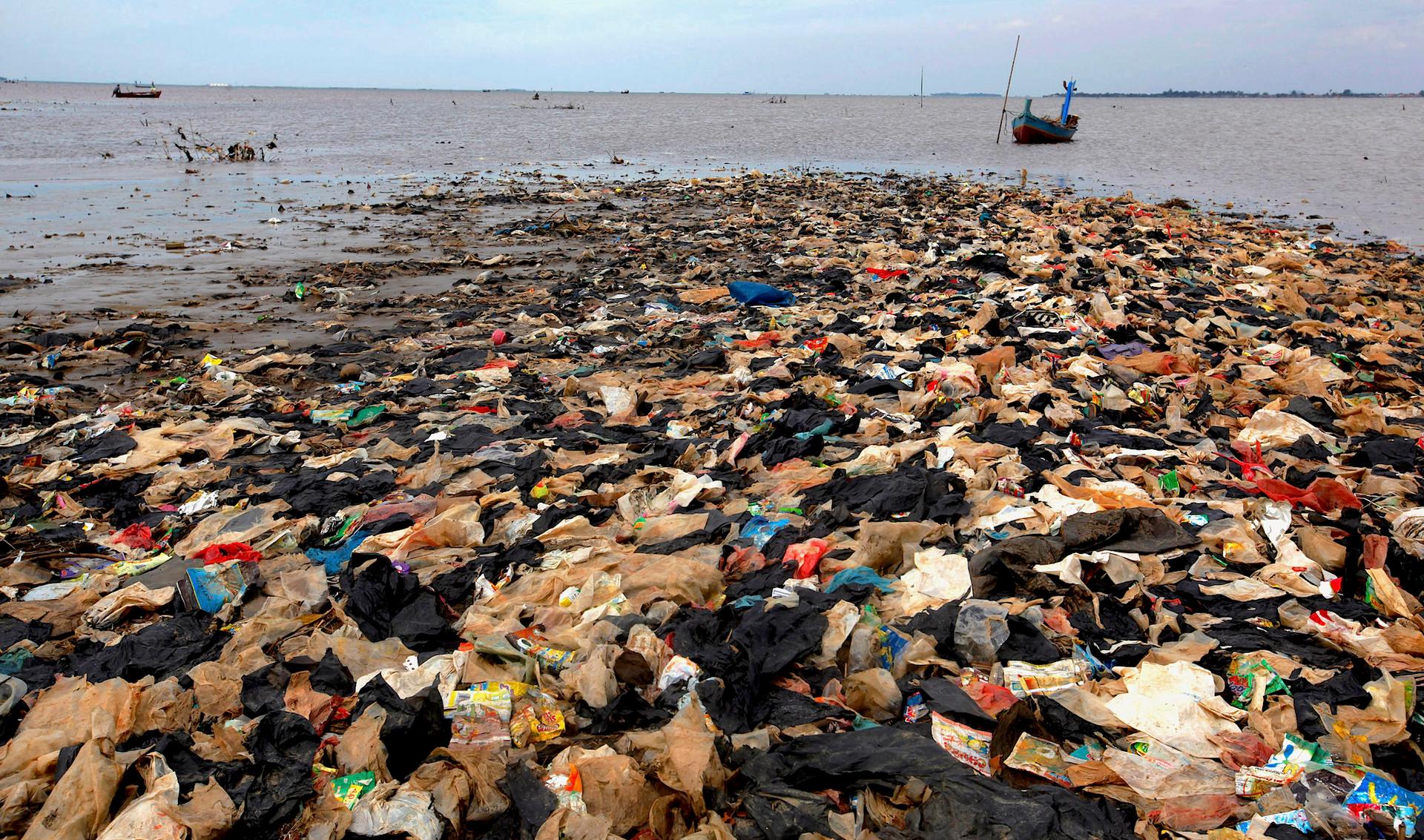Climate change, meet your apocalyptic twin: oceans poisoned by plastic
A small island formed by trash in Tanjung Burung, on the coast of Indonesia's Banten province, is pictured on June 5, 2013. According to a local resident, the trash originated from Jakarta and surrounding cities, accumulating in this area after flowing through rivers.
Here in this fishing village, on the island of Java, the surf teems with kaleidoscopic color. Each wave is littered with garish bibs and bobs.
The water is speckled with synthetic hues: Coca-Cola red, day-glo green and every other color in the crayon box. There are monochromes as well: buoyant white blobs that, at a distance, look like 1,000 invading jellyfish.
It’s all plastic trash, of course.
Here floats the detritus of 21st-century consumption: soda bottles, Pampers and, since this is Indonesia, lots of instant noodle wrappers.
Those jellyfish? Plastic shopping bags. You can go five kilometers into the sea, the village fishermen say, and never stop seeing those lousy plastic bags.
“It’s infuriating,” says Alec, a 39-year-old mussel catcher. He’s hunched over his boat’s outboard motor with a wrench, face streaked with motor oil. The engine is all gunked up with plastic.
“This happens almost every day,” he says. “We can barely work. No matter where you go, the sea is covered in plastic.”
Like so many other coastal villages around the world, plastic junk has brought ruin to this place. Called Muara Angke, it’s a settlement in the shadow of Jakarta, a megacity generating mountains of trash each day.
These shores were once among the world’s most coveted. For more than a millennium, waves of outsiders — from Hindu conquerors to rapacious Dutch colonists — lusted after the paradisiacal beauty of Java. But today, any seafarer arriving on this beach will find a saltwater garbage dump.
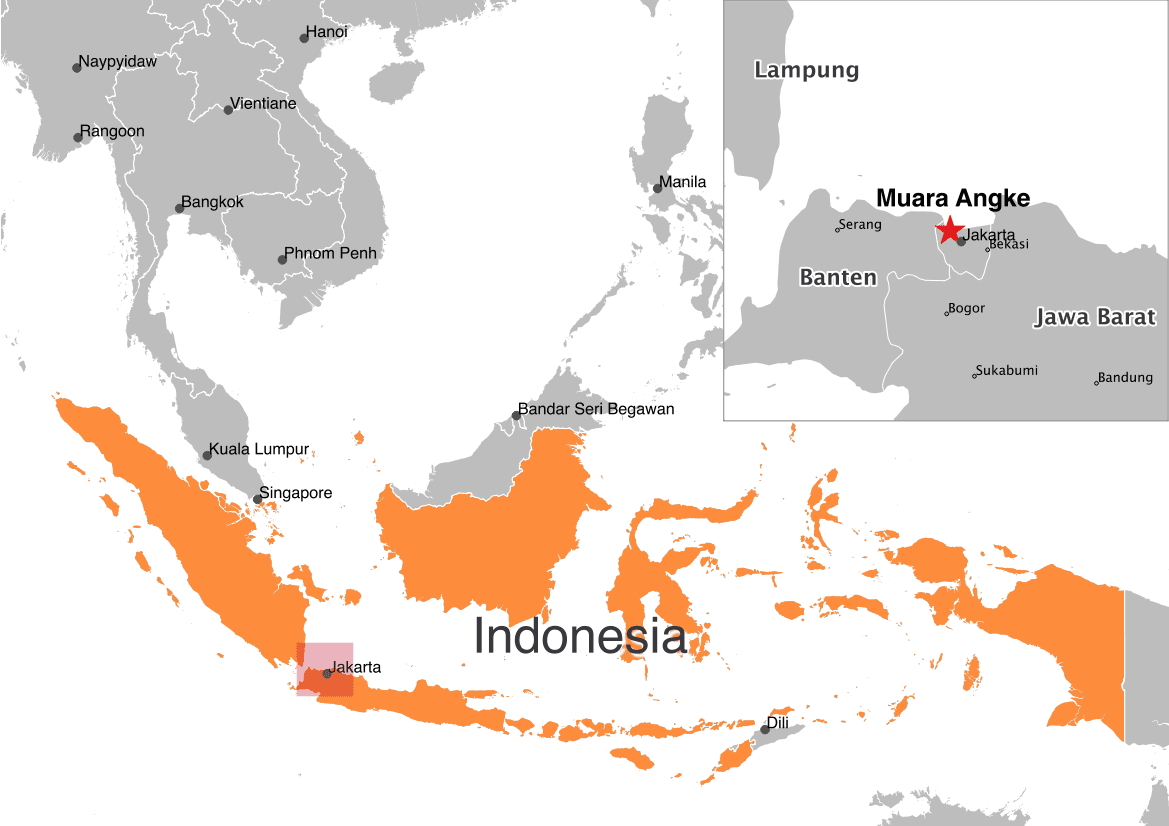
How terrifying. Not just for this village but for every human on the planet.
Westerners too often regard pollution in Asia as a far-flung curiosity — a tragedy to be pitied from a safe distance.
But when someone throws a dirty plastic spoon into the Java Sea, it doesn’t just float in place. Currents can carry it around the world and back in just 25 years.
All the while, it’s disintegrating into toxic crumbs. The ocean and its creatures are now awash in chemicals oozed by plastic — and it’s seeping into human bodies from Bali to Boston.
So ignore the floating spoon at your own peril. Its molecules, hiding in a bite of salmon, may someday swim through your bloodstream.
“We’re all infected with plastic,” says Seattle-based oceanographer Curtis Ebbesmeyer. “Molecules from some kid’s plastic bottle, dropped into the ocean in Asia, are winding up in the food Americans eat.”
Ebbesmeyer is best known for coining the phrase “gyres” — those massive whirlpools of trash swirling in the ocean. Five vortexes of filth now cover a whopping one-quarter of the planet’s surface. They get bigger every year.
As our disposable culture roars along, humans are transforming the ocean into a trash-strewn, cancerous stew. At this rate, by 2050, the seas will actually contain more plastic than fish.
This is not just gross. It’s an existential threat. All that seaborne plastic leaks chemicals that, when ingested, can weaken human sperm, potentially threatening our ability to reproduce.
“This is death by a million cuts,” Ebbesmeyer says. “It makes global warming look like child’s play.”
No country is immune. But the island of Java — a place with too many people and too few garbage trucks — just happens to be an excellent place to watch this crisis in motion.
Because if countries like Indonesia can’t turn off the spigot of plastic trash then, well, we’re all screwed.
*****
One of the countless luxuries Westerners enjoy is the illusion that plastic just vanishes.
It doesn’t. The lid to the Starbucks cappuccino you bought in 2007 is out there somewhere. So is every toothbrush you used in high school. So is every plastic water bottle you finished off in 45 seconds — and then tossed into a black bag that was also made from plastic.
Do you recycle? Great. So perhaps your sophomore-year toothbrush was transformed into a toy in Taiwan or a Turkish kid’s sippy cup.
But this probably didn’t happen. Less than 10 percent of America’s plastic is recycled — and much of the plastic placed in recycling bins actually ends up in a landfill.
But we’ll stay optimistic. Assume your toothbrush evaded the local dump. Odds are very high that it wound up in China, the primary recycler of America’s plastic waste. There, it may have been reincarnated as a drinking straw in Shanghai.
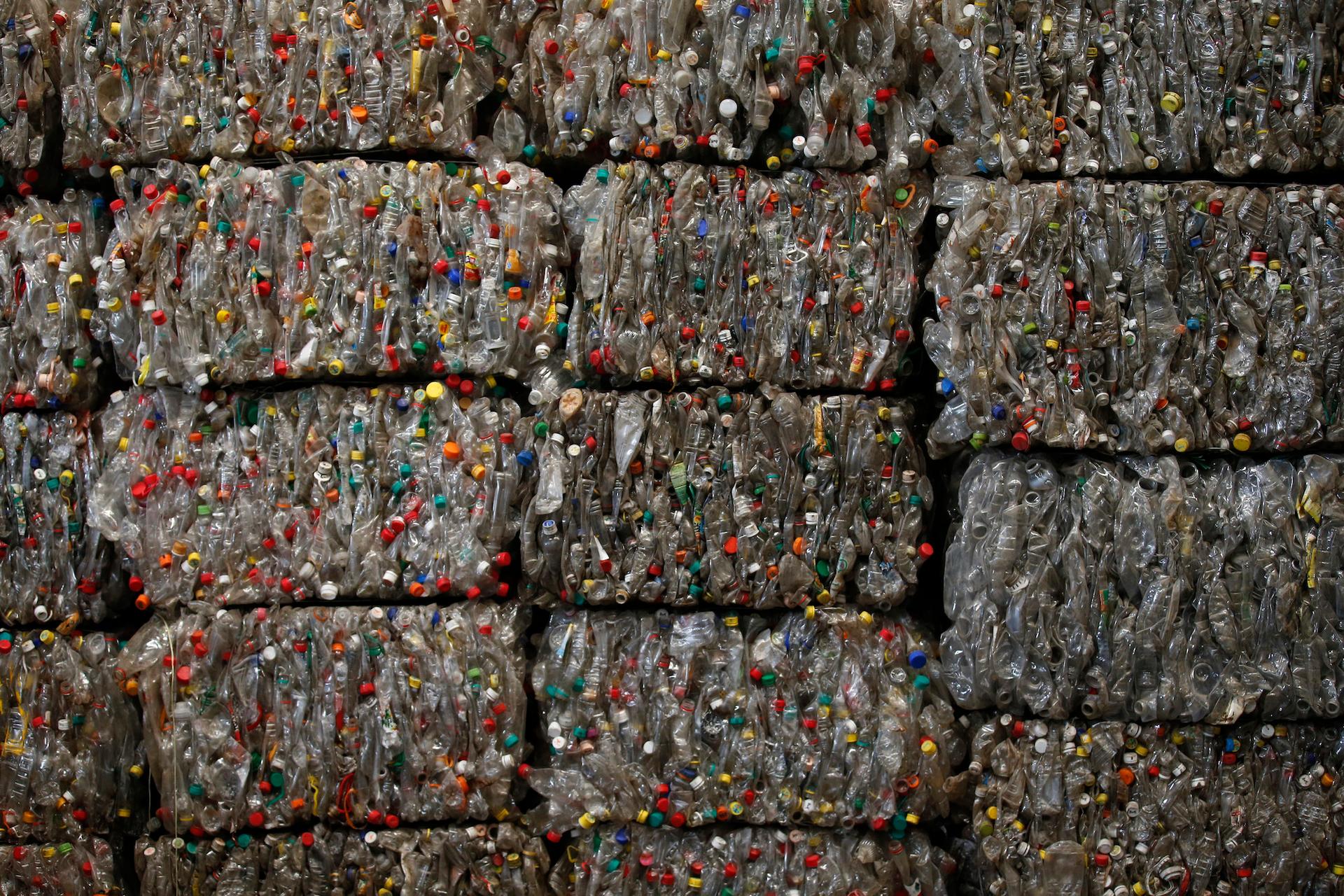
Still, at some point, that straw was thrown away — and less than half of China’s trash ends up in landfills.
A lot of it actually ends up in the ocean.
Imagine a globe with a circle drawn around China and Southeast Asia. More than half of the plastic pouring into the ocean comes from within this circle, according to extensive research published in the journal Science.
Herein lie five big offenders: Indonesia, China, the Philippines, Thailand and Vietnam. Add Sri Lanka, to the west, and you’ve got the top six plastic polluters on Earth.
What do all of these places have in common? Long shorelines. Populations that have boomed, and economies that have boomed, too. At least enough to turn millions of farmers, once nurtured solely from the land, into folks who can afford Pepsi and mobile phones.
When it comes to plastic consumption, people living in Asia are nowhere near as gluttonous as Americans, who throw out more than 45,000 plastic bottles per minute.
But in America (as in much of the West) waste chucked into a bin tends to end up in a mountainous dump, not the sea. Of all the plastic spewed into the ocean, the US contributes 1 percent. China is responsible for one-third.
So that Shanghai drinking straw, created from the polypropylene essence of your old toothbrush, is quite possibly bobbing in the Pacific.
Let’s hope it’s not gagging some poor tuna.
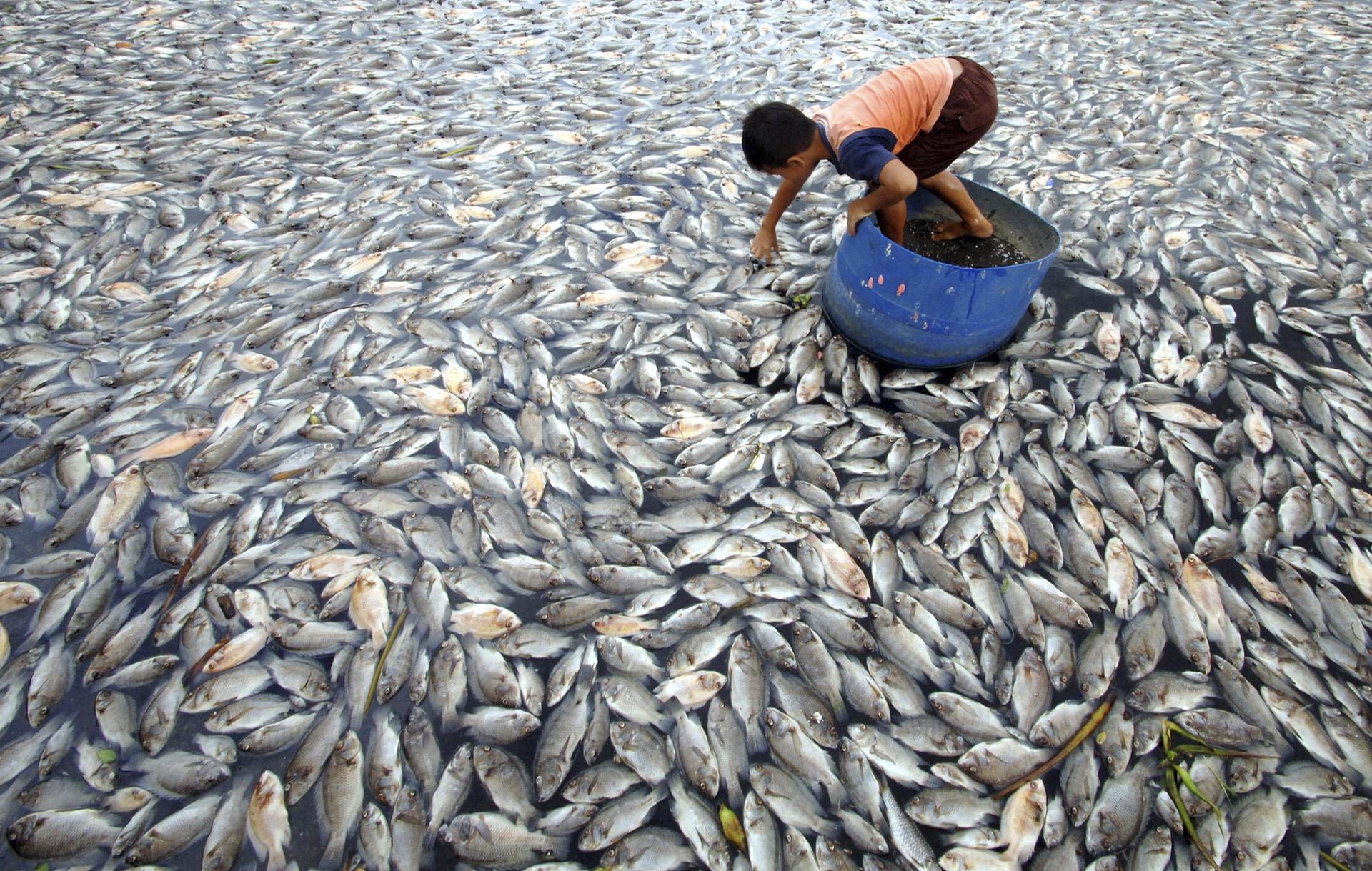
*****
Plastic is so omnipresent that it’s easy to forget what it actually is.
Plastic is mostly made from crude oil. This black goop, hundreds of millions of years in the making, is first sucked from the ground. Then it’s refined, blasted in furnaces and mixed with additives
The resulting material — plastic — can be molded into everything from spaceship parts to Mardi Gras beads.
Plastic is cheap and strong. It’s so durable, in fact, that it never really dies. A plastic soda bottle in the ocean may retain its shape for 400 years but, even after that, it breaks apart and lives on as poisonous confetti.
Just 100 years ago, everyday people barely used plastic. Now, thanks to multinational conglomerates, it’s the lifeblood of a disposable consumer culture spanning the globe. Plastic is enmeshed in the lives of billionaires and peasants alike.
But when it’s time to toss it away, a wealth divide emerges.
In America — or any place with a well-functioning waste disposal system — garbage trucks whisk away junk at least once a week.
At that point, plastic bottles, spoons and wrappers seem to disappear forever. But there are 3.5 billion people on Earth who know better.
No agency, public or private, comes to collect the plastic junk thrown out by roughly half of humanity. It often piles up at their feet.
*****
Aena, a tween girl from Muara Angke, is one of these people.
Her little Javanese village is a maze of houses assembled from tin sheeting and cheap plywood, some of it salvaged from the beach. The air smells of sea salt, mussels and rotting vegetables.
This settlement is drowning in plastic trash. “Trash bins? We don’t have many of those,” says Aena, 12, wearing flip-flops and Doraemon pajamas. “The only place to throw trash is on the ground or in the sea.”
Sometimes, village grandmas will rake all that plastic into a pile and set it aflame. It’s mostly crude oil, after all, so it lights up quick.
But trying to burn away all the garbage is almost futile. In this village, plastic junk litters every footpath and every patch of sand. When Aena and her friends scamper around the beach, you hear plastic crunching under little feet.
Much of this mess is churned out by Western multinationals: Proctor & Gamble and Unilever, Nestle and Coca-Cola. Some of the beach rubbish bears brand names, like Pantene or Cerelac, that would look familiar to a Wal-Mart shopper.
But on this side of the world, there are fewer jumbo-sized plastic containers. In Southeast Asia, Western corporations sell products in little packets — cheap portions that the poor can afford. They call the appeal of these mini-portions “masstige”: prestige for the masses.
That’s great for Aena. She may live in a shack made of scavenged planks. But she can wash her shoulder-length hair with “ICE COOL MENTHOL” shampoo made by Unilever. One small dollop sells for less than 10 cents.
It’s not so great for the sea. From Java to Vietnam, the waves glitter with thousands of little plastic packets. Once used, they’re worthless and practically impossible to recycle.
Aena says that, if she could wish away all this garbage, she would. “But honestly, we don’t think about it much. It’s looked like this my entire life,” she says. “Like our whole village is a trash bin.”
A few of Aena’s friends, gathered near the shore, giggle in agreement. One drains the last drop of sweet tea out of a plastic bottle and then chucks it over her shoulder. And why not? Littering has lost any sense of taboo. Even if she placed it in a trash bag, no one would come to haul it away.
*****
From Brazil to Vietnam, countless villages like this dot the world’s shorelines. If their inhabitants were the only people dumping plastic into the sea, our oceans would be in far better shape.
Unfortunately, the problem runs much deeper — and the island of Java helps explain why.
Java is one of the world’s most densely peopled islands: 141 million are squeezed onto a patch of land smaller than Louisiana. Many live by the shore. But many more live further inland in cities built up beside rivers.
In the latter half of the 20th century, when Asia went industrial, this island’s population skyrocketed. But Indonesia’s government — a young and quasi-dysfunctional democracy — has not kept up. The country offers regular trash services to only about half of its citizens.
So many families, deprived of dumpsters and garbage trucks, treat the local river as a trash chute.
Tossing trash into waterways is a fairly common practice from Latin America to the Indian sub-continent. River currents act as a conveyer belt, sweeping junk over the horizon and out of sight.
But these days, in Java, rivers can grow so clogged with trash that the water is barely visible.
Take the Cikapundung River. For millennia, the river has bathed and nourished the people of Java. Its coffee-colored water snakes around volcanoes before emptying into the Java Sea.
Now, on a bad day, it is an undulating ribbon of wet garbage. And the rest of Java’s dozen or so rivers aren’t faring much better.
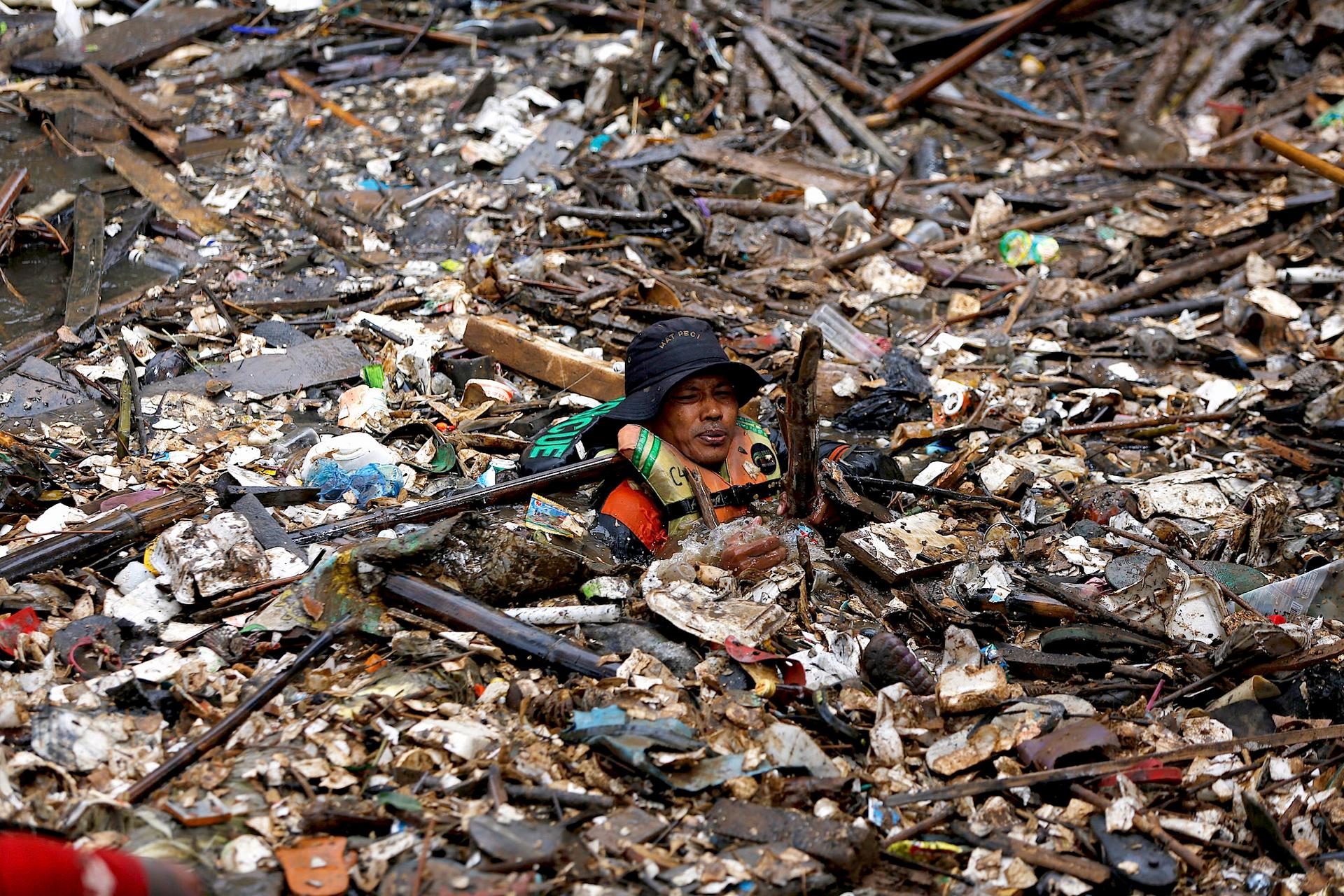
In recent years, these rivers have suffered the equivalent of coronary ruptures. Like blood clots, all that junk can block riverine arteries until — SPLOOSH! — the water gushes on shore.
These man-made floods send soggy styrofoam washing into people’s living rooms. This isn’t merely disgusting. Turning neighborhoods into sewers is potentially deadly. Water-borne infections prey on children and grandparents. And disease, carried by mosquitoes and panicked rats, can prove fatal.
*****
Late last year, Java’s rivers were so plugged up that the government proclaimed a garbage “state of emergency.”
It was a rallying cry for cities to crack down on littering — often in the form of heavy fines totaling around $40 per violation. For the many Indonesians who eke by on $2 per day, that’s a life-ruining sum.
“Before, when we were caught, the cops would just give you a lecture. Or maybe make you do six push-ups,” says Agus Ahmad, 50, the ex-headman of a district in Bandung. The city of roughly 2.5 million is infamous for its polluted waterways.
“Now people are more afraid to throw plastic in the river,” Agus says. “Or at least they’re afraid to get caught.”
Ingrained habits explain part of Indonesia’s trash epidemic, says Yayat Supriatna, an urban planning scholar who has advised the government. “People don’t understand how dangerous plastic can be.”
But so far, he says, the government’s strategy is emphasizing scare tactics over actually hauling away more junk. Only about 40 percent of Javanese homes get “good trash service,” he says, and the population never stops growing.
“What’s the point of fining people? You’re punishing them but you’re not holding up your end of the deal by picking up their trash,” Yayat says. “That’s an injustice.”
So people continue to rebel.
“Adults still throw stuff in the river. They’re just doing it at night,” says Muhammad Randika, an 11-year-old in Bandung. His little neighborhood is called Braga, a labyrinth of stone pathways designed by Dutch colonists.
He lives above a soupy canal. For Muhammad and his pals, this fetid tributary doubles as a swimming hole. They have come to know it as a place where grown-ups try to make stuff disappear: bags stuffed with diapers, intestines from sacrificed cows, even homicide victims.
“Not that long ago, we swam across a floating dead man with a slashed throat,” says Muhammad, flanked by a gaggle of boys in flip-flops. “His face was as white as yours.”
The throng of kids nod along. “That won’t stop us from swimming here though,” Muhammad says. “There’s nowhere else to go.”
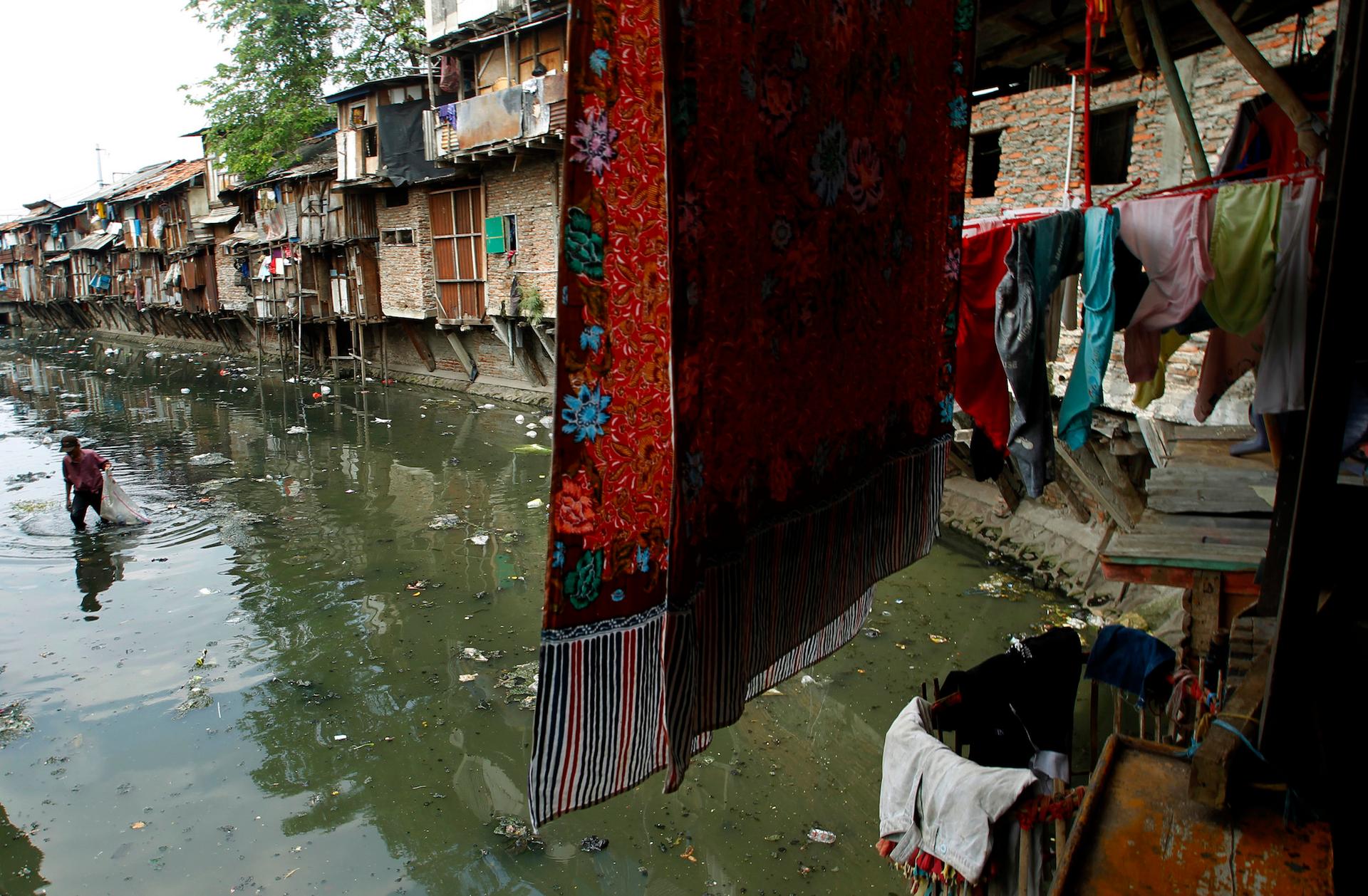
*****
“Have you checked your son’s sperm count lately?”
That’s how Ebbesmeyer, the oceanographer, will sometimes greet audience members who come to hear his lectures on ocean debris.
“If you want to see how fast you can stop a conversation, try talking about sperm counts,” he says. “That’ll do it.”
Awkward, perhaps, but not nearly as unpleasant as the fall of humanity.
Studies indicate that, in the last 50 to 70 years, human sperm has grown less potent. One of the more comprehensive studies, conducted in France, shows sperm counts plummeting by 30 percent in less than two decades — and it’s continuing to drop.
Why is this happening? Scientists aren’t sure. Potential causes range from pollution to obesity to drinking from aluminum cans. But the fact that sperm counts are falling so fast, according to leading fertility researcher Richard Sharpe, suggests the causes “must be lifestyle and environmental.”
Mounting evidence suggests the culprit could be estrogen. Not the naturally occurring hormone, but its evil cousins — chemicals in consumer goods that mimic estrogen’s effects.
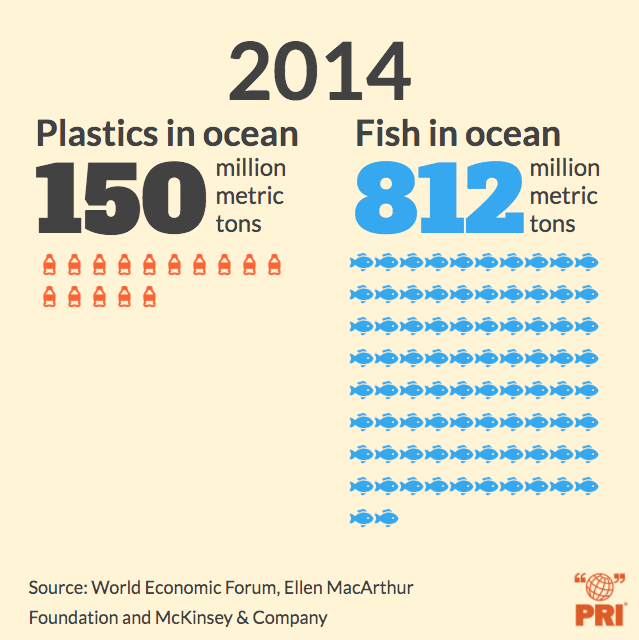
There are roughly 5,000 of these chemicals lurking in our everyday products. Plastic is most often their Trojan horse. In fact, research shows “almost all” plastics ooze estrogen imitators.
*****
The most notorious of these estrogen imitators is Bisphenol A, or BPA.
This substance is already on the radar for many consumers, who seek out BPA-free plastics. But BPA (and BPS, its equally worrisome sibling) is almost impossible to avoid. It’s in everything from canned goods to Tupperware.
You probably have traces of this stuff in your blood. More than 90 percent of Americans do. And you don’t want more than a trace.
A large body of experts, after reviewing hundreds of studies, declared that the amount of BPA already found in “the typical human living in a developed country” could potentially bring on maladies from weak sperm to cancer.
But don’t worry, says the $374 billion plastics industry. Its lobbyists and sponsored studies contend that small amounts of BPA won’t hurt humans. Corporate advocacy groups, such as Facts About BPA, concede that the substance is “weakly estrogenic” but say it is harmlessly peed out by consumers.
Indeed, the World Health Organization notes the “potential toxic and hormonal properties of BPA” but notes no adverse effects from small doses.
For now, the FDA, which has relied in part on industry-funded studies, is on the manufacturers’ side.
Let’s hope they’re right. Because just look at what this stuff can do to animals.
It can reverse a rat’s gender and alter its genitals. It causes pregnant monkeys to birth deformed babies.
It can even lurk in an animal’s cells to sabotage future generations.
A fish tainted with BPA may have babies with no problems. But its children — and even grandchildren — will become less fertile. According to a University of Missouri study, the chemical could have similar “adverse reproductive effects” on humans.
A biological scientist and well-known BPA critic named Frederick vom Saal, speaking to Mother Jones magazine, puts it succinctly: “A poison kills you. A chemical like BPA reprograms your cells and ends up causing a disease in your grandchild that kills him.”
Just as BPA swims around in our blood, it’s saturating our plastic-strewn seas. When researchers took seawater samples from 200 sites across the US and Asia, they found “significant” levels of BPA in every single one.
All this research has brought Ebbesmeyer, an elder statesman of sea pollution research, to a grim conclusion.
Plastics in the ocean, he says, may threaten existence as we know it.
“Mother Nature is getting rid of us by our own sword,” he says. “Of all the potential nastiness out there, humanity’s inability to reproduce is at the top. But no one wants to talk about it.”
In Ebbesmeyer’s view, this end-of-days scenario could outpace the ravages of climate change. To hear him tell it, our extinction could look like a mash-up between “An Inconvenient Truth” and “Children of Men,” the 2006 thriller in which infertility plunges the world into chaos.
“Humanity is pretty good at avoiding the important questions,” Ebbesmeyer says. “I think the evidence here is pretty conclusive.”
*****
Perhaps this extinction-by-estrogen scenario is overly apocalyptic.
In the meantime, this is what we know for sure.
Humans are disgorging 8 million tons of plastic into the sea each year. Before we know it, those whirlpools of junk in the ocean could soon cover half the planet’s surface.
This junk is killing off millions of creatures. Plastic-infected fish are turning up on our dinner plates. In some parts of the sea, there’s six times more plastic in the water than plankton.
This nightmare begs a number of questions. Among them:
Can humans clean up all this mess?
There are 5.2 trillion bits of plastic in the sea, according to the 5 Gyres Institute.
That’s 52 times the estimated number of stars in the Milky Way.
The answer is probably no.
Can we at least stop leaking plastic into the sea?
Perhaps. But it’ll be expensive.
In the leakiest plastic-pollution zone on the planet — China plus Southeast Asia — waste disposal systems are underfunded, opaque and often corrupt, according to the non-profit Ocean Conservancy.
The group has tried to calculate the cost of overhauling this region’s waste systems to keep plastic out of the sea.
Their figure: $4.5 billion per year, sustained throughout a decade.
That’s a lot, sure, but it’s not an inconceivably high sum. The US hands that much money to the militaries of Egypt and Israel each year — all in the name of protecting American interests.
But at the moment, overhauling Asia’s trash crisis is an environmentalist fantasy. There’s no indication such an effort will be funded by anyone — not countries in Asia, nor the United Nations, nor billionaire donors.
Counting on the United States government to lead the fight against this scourge seems particularly futile. The White House, under incoming President Donald Trump, won’t even concede that climate change is a massive threat. The odds of a fringe issue like plastic pollution appearing on his agenda appear close to nil.
There are flickers of hope, however. China has banned the thinnest plastic bags, which are difficult to recycle and prone to tangle up with just about anything floating by. So has a busy district in Manila, the Philippines capital.
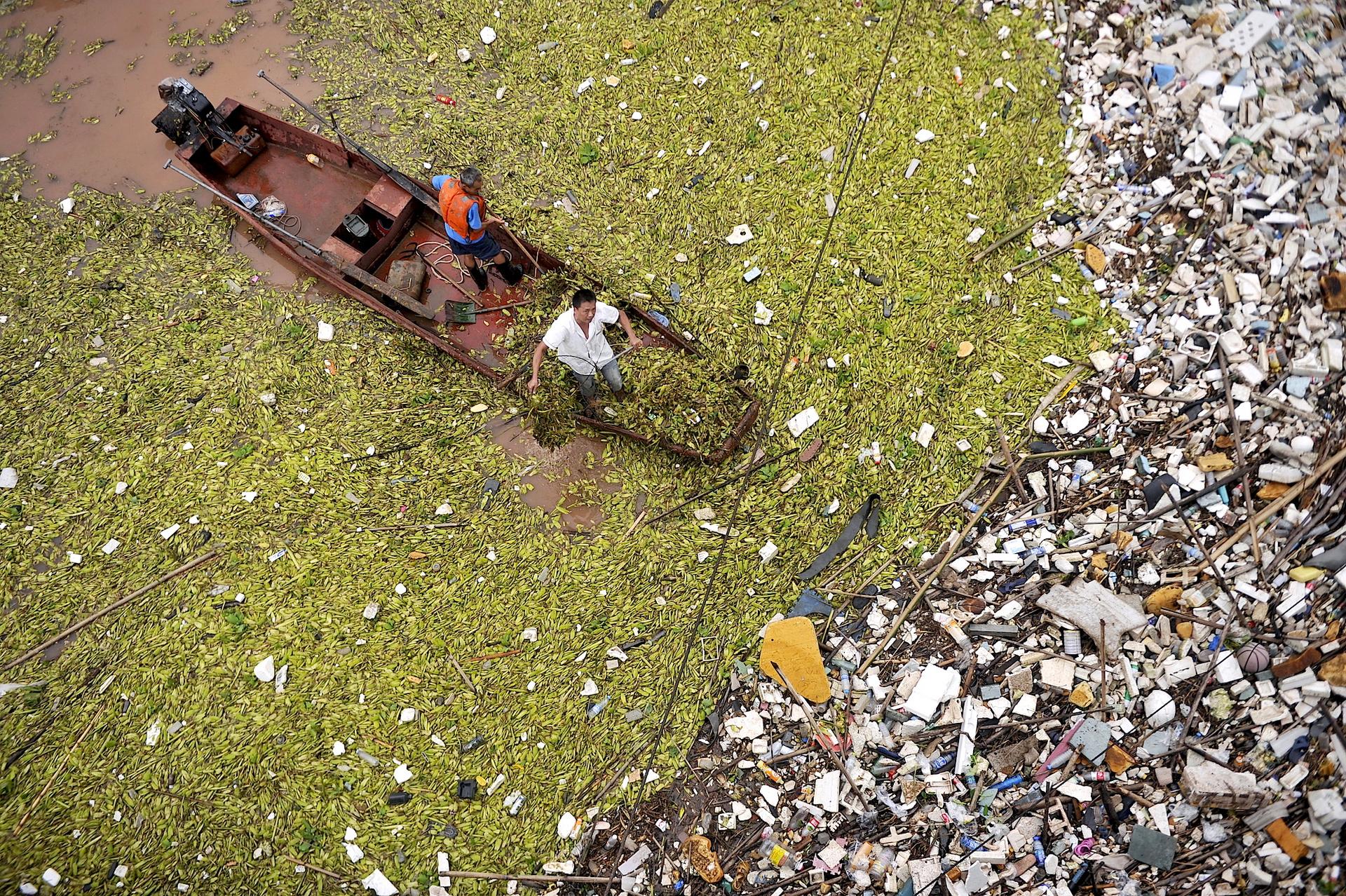
In Jakarta, the local government is deploying 4,000 people — paid $60 per week — to dredge plastic junk out of rivers before its hits the ocean. Locally, this endeavor is enormously popular.
But even if this approach were replicated from Lagos to Buenos Aires, armies of trash scroungers can’t save the seas. Any trash that plops into a river is likely to reach the ocean. Cities and towns generate far too much pollution for people to collect by hand.
What are plastics corporations doing to help?
Not enough. Especially in countries such as Indonesia, where regulatory agencies are comparatively weak.
“The corporations may offer a bit of charity here and there,” Yayat says. “But they don’t really help. They’ll say the environment is the government’s responsibility.”
Even the US won’t rein in its plastics industry. According to the Union of Concerned Scientists, lobbyists are working overtime to keep plastics “unregulated or under-regulated.”
This scientists’ union also accuses the American Chemistry Council, a powerful pro-plastic trade association, of “following a pattern modeled by the tobacco industry: deny the science, bring in its own experts to counter the evidence” and pressure lawmakers to maintain the status quo.
Neither of the plastics industry’s top BPA lobbies, Facts About BPA and BPA Coalition, responded to PRI’s questions about the chemical's contamination of the sea.
*****
So, what’s the solution?
“If you produce plastic, it’s assured that it will eventually end up in the sea,” Ebbesmeyer says. “So we have to stop producing plastic.”
This is a fairly radical notion. Even hardcore environmentalists struggle to rid their lives of plastic.
Humans worldwide use roughly one million plastic bags per minute. Americans — among the world’s most unrepentant plastic junkies — toss 2.5 million plastic bottles per hour.

Killing off disposable plastics would end our way of life. It would slaughter convenience on the altar of ecology. We’re addicted to plastic. It’s literally in our blood.
Maybe we could revert back to glass. Or we could transition to bio-plastics, made from plants such as corn or soy. But as it stands, bio-plastics are more expensive to produce and amount to a tiny portion of the overall plastics market.
As with global warming, humanity might be too myopic to alter its behavior before the oceans are ruined. But what many Western environmentalists often fail to see is that their domestic efforts — like banning plastic bags in Portland — will never be good enough.
Even if the US federal government embraces the most enlightened anti-plastics policy possible, a fanciful notion at best, that wouldn’t spare the ocean from catastrophe. Any potential solution must be executed globally.
As long as Java and places like it gush tons of plastic into the ocean — all while corporations in Europe and the US profit — our bodies will steadily soak up more and more plastic residue.
Perhaps you are among the wealthy minority of humans who have great control over what you eat for dinner. Fearful of estrogenic chemicals, you can quit eating ocean-caught fish. (You’ll also want to swear off other main contributors of BPA to human blood: canned drinks and chemical-laced paper receipts.)
But even if you succeed, that won’t spare the billions of less fortunate people who rely on fish as a primary protein. Nor will it spare the fish themselves. At this rate, in a few decades, there will be more plastic swishing about the ocean than fish.
The full implications of this crisis remain unknown. Many environmentalists portend doom. Conglomerates tell us not to fret.
As for Ebbesmeyer, he’s betting on disaster.
“These endless shenanigans are driving us toward mass extinction,” he says. “We’re one of the many animals that will become extinct — ironically by our own intelligence.”
Every day, reporters and producers at The World are hard at work bringing you human-centered news from across the globe. But we can’t do it without you. We need your support to ensure we can continue this work for another year.
Make a gift today, and you’ll help us unlock a matching gift of $67,000!
